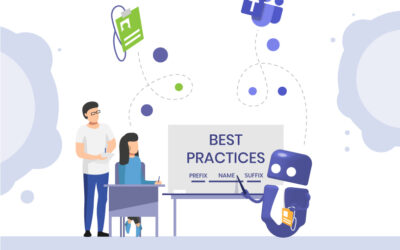Microsoft 365 Extranet: External Sharing Portals for B2B in SharePoint or Office 365
Why does your company need an extranet in Microsoft 365?
Many companies use an extranet when collaborating with partners, customers, or service providers. An extranet can improve internal processes, communication, file sharing, and transparency.
However, a poorly planned extranet can also pose risks:
- Uncontrolled guest access
- No clear separation between internal and external data
- Security gaps due to shared files
- Compliance issues if access is not properly documented
For IT administrators and governance teams, this means: More risk, more effort, and less transparency. If you want to make external collaboration clean, secure, and traceable, you need a well-structured extranet.
What is the difference between an intranet and an extranet?
An extranet is a protected area where external partners can access selected information, documents, or processes.
Difference from an intranet:
- Intranet: For internal employees only
- Extranet: For external users with clearly defined permissions
In Microsoft 365, extranets are usually implemented via SharePoint sites, Teams channels, or dedicated external portals.
Invite externals to M365 security groups?
What is an intranet?
An intranet is a private, internal network that is restricted to an organization’s employees or authorized personnel. It uses internet protocols (e.g. TCP/IP) but operates behind a firewall, making it inaccessible from the public internet.
The main purpose of an intranet is to serve as an Internal Communications tool for sharing information and documents with employees and internal departments.
Access to an intranet is typically restricted by authentication mechanisms, such as email address and password combinations, and is only available to individuals within the organization. It can be accessed from within the corporate network or through a VPN (Virtual Private Network) for remote employees.
Within Microsoft 365, an intranet can be built with tools like SharePoint Online, Viva, and Microsoft Teams, made accessible only to employees or authorized users within the organization. An intranet based on M365 can employ its security features, such as Entra ID (formerly Azure Active Directory or AAD) for authentication and role-based access control (RBAC).
What is an extranet?
The meaning of „extranet“ is a collection of data that extends „outside“ or „beyond“ the borders of a company. An extranet is a private network that allows controlled access to authorized external users (such as business partners, suppliers, or customers).
An extranet’s main function is to facilitate business-to-business (B2B) or business-to-customer (B2C) interactions. It allows external stakeholders to access certain internal resources, share data, and collaborate on specific projects.
Extranet access is granted through secure authentication methods similar to those used in intranets, but with additional layers of security to manage external connections. External users might connect via secure web portals, VPNs, or specific access credentials.
An extranet built in Microsoft 365 allows a company to share e.g. SharePoint sites or Teams channels with external partners or clients.

What use cases are suitable for an extranet in Microsoft 365?
Typical scenarios for an extranet:
- Partner portals
- Customer portals for document exchange
- Supplier portals with order information
- Project portals for external service providers
- Support portals for collaboration with agencies
In a Microsoft 365 (M365) extranet setup, you can provide external partners, suppliers, and customers with secure remote access to resources within your organization’s environment. You can create dedicated SharePoint sites or Teams channels or even a full extranet portal for external stakeholders to share and collaborate on documents, manage projects, and communicate in real-time.
For example, you might have a SharePoint site where suppliers can access and update delivery schedules or a partner portal where you manage ongoing projects with external contractors and provide information on your products. This setup ensures that all parties are always working with the most current information, while maintaining strict control over who has access.
How can you set up an extranet in Microsoft 365?
Extranet with SharePoint Online
SharePoint offers good conditions for an extranet:
- Own site collections
- Permissions at site or library level
- Clear separation of internal and external areas
- Customizable branding and navigation
- Secure collaboration with external partners, customers, or suppliers
SharePoint is ideal when external users need structured documents and processes.
Microsoft Teams as an extranet for collaboration
Microsoft Teams is suitable when external partners are to actively collaborate.
Typical setup:
- Separate team for each partner or project
- Clearly separated channels
- SharePoint library in the background
- Chats, files, meetings, and tasks in one place
- Structured invitation of external users
Teams is particularly suitable when external collaboration takes place on an ongoing basis.
Which method is suitable for your extranet scenario?
| Method | Advantages | Limitations |
|---|---|---|
| SharePoint Online | Structured document libraries, clear permissions, branding possible | Less suitable for ongoing communication |
| Microsoft Teams | Exchange, meetings, files, and chat in one tool | Permissions can quickly become complex |
| Combined approach | Flexible collaboration plus structured document storage | Clear governance necessary |
How does user management work in a SharePoint extranet?
In a SharePoint extranet, external users are managed via Entra ID B2B (formerly Azure AD B2B). External individuals are added as guest users and can log in with their own company account or a personal Microsoft account. This keeps authentication secure without the need to create separate accounts.
A central component of extranet control is the precise assignment of permissions. Administrators determine which sites, libraries, or folders external users are allowed to view or edit. Internal users can also be assigned as delegated administrators to adjust permissions for external partners without being granted full administrator rights.
For more efficient management, invitations, permission changes, and access checks can be automated using an extranet user manager tool. This facilitates compliance with security and compliance policies and reduces the workload on the IT department.
What should administrators know about extranets?
When setting up and managing an extranet, admins should consider these key factors and best practices:
1. Secure access management
Each extranet portal should use secure authentication, e.g. through Azure AD B2B, to manage access and identity. Two-factor authentication (2FA) or multi-factor authentication (MFA) is recommended for enhanced security, especially when sensitive information is involved.
2. Defined permissions and access control
Implement strict permissions within the extranet partner portal or extranet vendor portal. Granular permissions ensure that each external user has access only to the resources necessary for their role. Role-based access control (RBAC) and user group segmentation can further secure the portal, ensuring data is segregated based on need-to-know criteria.
3. Monitoring and compliance
Set up activity logging and access monitoring to keep track of actions within the extranet portal. This helps with compliance reporting and allows admins to identify any suspicious activity. Regular audits of permissions and user activity within the extranet help ensure ongoing security and alignment with compliance requirements.
4. User experience and branding
For external stakeholders, the extranet should be easy to navigate, clearly branded, and structured for intuitive use. Simplified navigation, clear document organization, and consistent branding within the extranet partner portal can enhance collaboration by making resources easy to find and interact with.
5. Content management and collaboration tools
Since extranets are used for collaboration with external parties, the extranet vendor portal should be integrated with tools like SharePoint and Microsoft Teams to allow seamless document sharing, co-authoring, and real-time updates.
6. Automated user management
Using extranet-specific user management tools can simplify guest onboarding, permission adjustments, and removal processes for external users. Automated workflows for inviting and removing external users can help reduce administrative workload while maintaining access control.
Why is extranet security so important?
For intranets, ensuring a secure environment is easier: Intranets can focus primarily on internal security, with limited exposure to external threats. Since intranets are isolated from the public internet, it benefits from enhanced security. Firewalls, access controls, and encryption protocols are commonly used to protect sensitive information.
Extranets, however, face greater security risks due to external connections, thus requiring more and stricter security measures.
Admins managing an extranet setup need to prioritize extranet security just as much as, for example, Microsoft Teams governance, in order to protect against data breaches, unauthorized access, and compliance risks. Here’s a breakdown of what they need to know!

Authentication and access control to extranet
To mitigate extranet security risks, admins should enforce strict authentication protocols. Using multi-factor authentication (MFA) and Entra ID B2B (formerly Azure Active Directory B2B) for external user management in a SharePoint extranet security context helps ensure only verified users receive guest access to resources. MFA adds an extra layer of security, reducing the likelihood of unauthorized access through compromised credentials.
Granular permissions
SharePoint extranet security allows admins to implement fine-grained access control, defining which users or user groups can access specific sites, libraries, and documents. By applying role-based access control (RBAC), admins can segregate access by role (e.g., partner, vendor, or client), minimizing the risk of unauthorized data exposure.
Data protection and encryption
Data within a SharePoint extranet should be encrypted both at rest and in transit. Microsoft 365 supports BitLocker encryption for stored data and TLS encryption for data in transit. Ensuring that sensitive documents are restricted to the appropriate users and applying sensitivity labels can further safeguard data within the extranet.
Monitoring and alerts
Proactive monitoring is essential to identify potential security incidents early. Audit logging and Azure AD monitoring tools enable admins to track login attempts, data access, and permission changes within the extranet. Alerts can be set up to notify admins of suspicious activities, such as multiple failed login attempts or access from unusual locations.
Periodic security reviews
Regular audits of permissions, user activity, and access policies are necessary to ensure compliance and security integrity. By periodically reviewing access levels, especially for external users, admins can promptly revoke unnecessary permissions and update security policies to adapt to emerging extranet security risks.
How does External User Manager support an extranet?
With an extranet, the most important question is: Who is allowed external access—and for how long? External User Manager (EUM) supports exactly that.
External User Manager can invite external users to a Microsoft 365 security group, which is then authorized to access specific communication pages on your SharePoint extranet.
EUM offers the following extranet scenarios:
- Approval workflows for external access
- Expiration and review rules for guest accounts
- Central overview of all external users in Microsoft 365
- Insights into externally shared files.
- Documentation of all invitations and changes
- Security & compliance: Mandatory signing of important documents (e.g., confidentiality agreements, communication guidelines, data protection agreements)
This keeps your extranet secure, cleanly structured, and auditable without additional administrative effort.
What is the best way to start an extranet in Microsoft 365?
For a structured extranet, you need:
- A clear authorization concept
- Clearly separated work areas
- Defined processes for external approvals
- Regular review of external access
- Automated workflows to reduce the burden on IT
With clear structures, good authorization rules, and moderate automation, you can ensure that external collaboration remains secure and efficient.
Tools such as the External User Manager help you to integrate external users in a controlled, compliant, and traceable manner.
Automate your external access management:

Chief Commercial Officer and Governance Specialist at Solutions2Share
Florian Pflanz has more than 8 years of experience with Microsoft 365 and has supported over 250 workshops on Teams governance.
His focus lies on lifecycle management, provisioning, and compliance requirements in regulated industries.
He shares best practices with IT admins and decision-makers to reduce complexity and strengthen secure collaboration in Teams.





